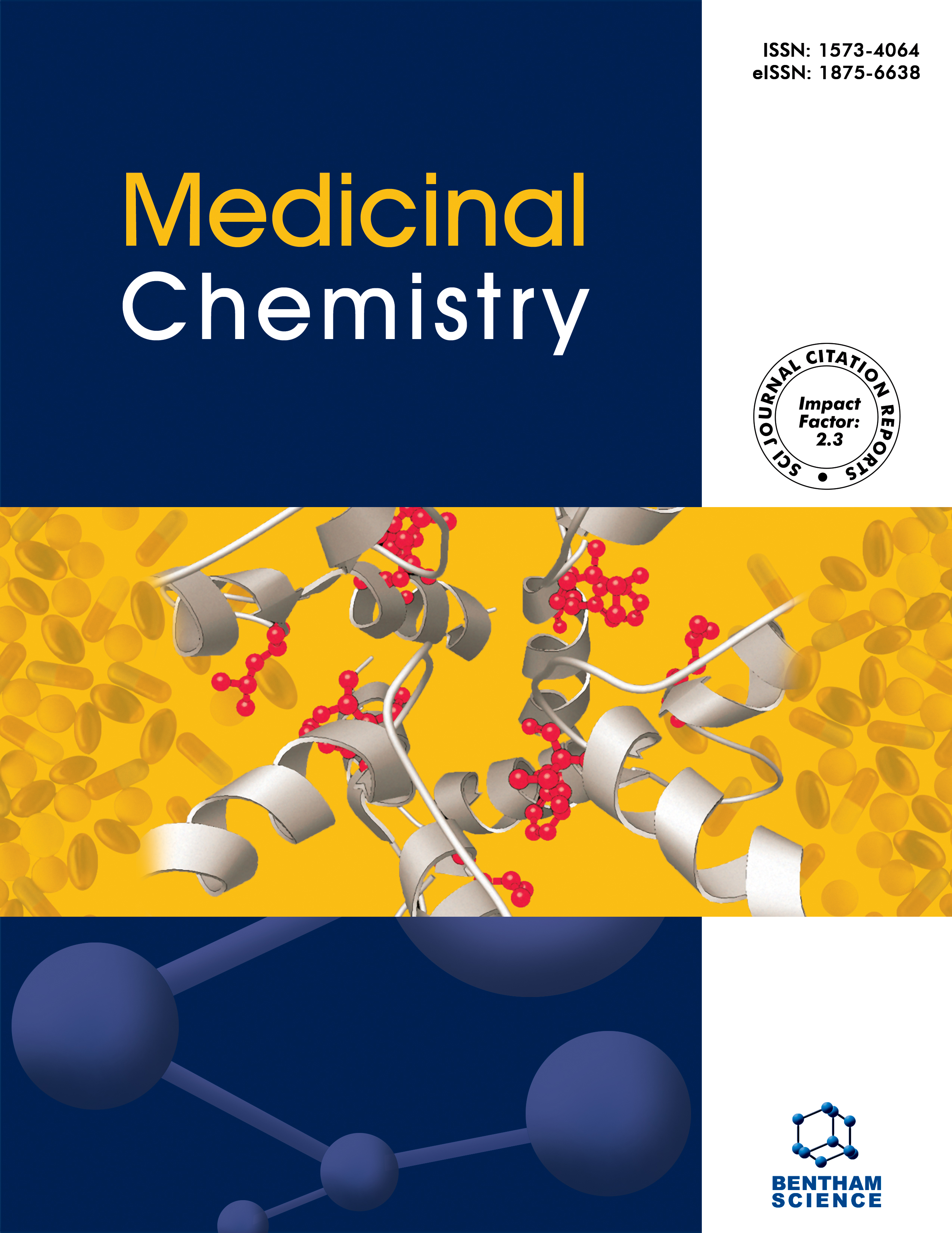- Home
- A-Z Publications
- Medicinal Chemistry
- Previous Issues
- Volume 18, Issue 1, 2022
Medicinal Chemistry - Volume 18, Issue 1, 2022
Volume 18, Issue 1, 2022
-
-
Synthesis and Clinical Development of Palbociclib: An Overview
More LessAuthors: Debabrata Konar, Saurabh Maru, Subhabrata Kar and Kapil KumarBreast cancer is the second most commonly identified cancer in women in the United States after skin cancer. The past few years have seen a substantial increase in breast cancer awareness campaigns and active research in fields of diagnosis and targeted therapy. These factors have led to a better mechanistic understanding of the disease, detection at earlier stages, and a more personalized approach to treatment, ultim Read More
-
-
-
Synthesis and Biological Evaluation of 4-Aminoantipyrine Analogues
More LessAuthors: Houwei Ren, Premnath Dhanaraj, Israel V.M.V. Enoch, Mosae S. Paulraj and Indiraleka M.Objectives: The aim of the present study is to carry out a simple synthesis of aminoantipyrine analogues and exploration of their antibacterial, cytotoxic, and anticonvulsant potential. Methods: The compounds were characterized employing multi-spectroscopic methods. The in vitro pharmacological response of a series of bacteria was screened employing serial dilution method. The derivatives were screened against Read More
-
-
-
Synthesis, Cytotoxicity, ADMET and Molecular Docking Studies of Some Quinoline-Pyrimidine Hybrid Compounds: 3-(2-Amino-6-arylpyrimidin-4- yl)-4-hydroxy-1-methylquinolin-2(1H)-ones
More LessAuthors: Duong N. Toan, Nguyen Dinh Thanh, Mai Xuan Truong and Dinh Thuy VanAims: This study aims are the synthesis of 3-(2-amino-6-arylpyrimidin-4-yl)-4-hydroxy-1- methylquinolin-2(1H)-ones and estimation their anticancer activities on HepG2 and KB cancer lines. Background: Many derivatives of quinoline-2-on have been interested to synthesize and evaluate their biological properties by organic chemists due to their various biological effects, including antibacterial, antioxidant, anti-inflammatory, a Read More
-
-
-
A Combined Approach of Pharmacophore Modeling, QSAR Study, Molecular Docking and In silico ADME/Tox Prediction of 4-Arylthio & 4-Aryloxy-3- Iodopyridine-2(1H)-one Analogs to Identify Potential Reverse Transcriptase Inhibitor: Anti-HIV Agents
More LessAuthors: Debadash Panigrahi, Amiyakanta Mishra, Susanta K. Sahu, Mohd. Afzal Azam and C.M. VyshaagBackground: Reverse transcriptase is an important therapeutic target to treat AIDS caused by the Human Immunodeficiency Virus (HIV). Despite many effective anti-HIV drugs, reverse transcriptase (RT) inhibitors remain the cornerstone of the drug regimen to treat AIDS. In the present work, we have expedited the use of different computational modules and presented an easy, costeffective, and high throughput screening me Read More
-
-
-
Chalcones as Scavengers of HOCl and Inhibitors of Oxidative Burst: Structure-Activity Relationship Studies
More LessAims: This study evaluates the ability of chalcones to scavenge hypochlorous acid (HOCl) and modulate oxidative burst. Background: The chemistry of chalcones has long been a matter of interest to the scientific community due to the phenolic groups often present and to the various replaceable hydrogens that allow the formation of a broad number of derivatives. Due to this chemical diversity, several biological activities have be Read More
-
-
-
In vitro Synthesis, Structure Elucidation, and Antioxidant Properties of Platinum(IV)-hydrazide Complexes: Molecular Modeling of Free- Hydrazides Suggested as Potent Lipoxygenase Inhibitor
More LessAuthors: Rooma Badar, Uzma Ashiq, Rifat A. Jamal, Parveen Akhter, Mohammad Mahroof-Tahir, Sana Gul and Syed Tahir AliBackground: A combination of biologically active ligand and metal in one molecule may increase the activity and reduce the toxicity. Objectives: In this study, the synthesis and characterization of platinum(IV) complexes with bioactive hydrazide ligands are discussed. Method: Elemental analysis, conductivity measurements, and spectroscopic studies were used to elucidate the structure of complexes. Results: Our study suggests t Read More
-
-
-
In vitro, In vivo and In silico Antihyperglycemic Activity of Some Semi-Synthetic Phytol Derivatives
More LessBackground: Due to the prevalence of type-2 diabetes across the globe, there is an unmet need to explore new molecular targets for the development of cost-effective and safer antihyperglycemic agents. Objective: Structural modification of phytol and evaluation of in vitro, in vivo and in silico antihyperglycemic activity of derivatives establishing the preliminary structure activity relationship (SAR). Methods: The semi-syn Read More
-
-
-
Synthesis, Cytotoxicity, Anti-Migration and Anti-Invasion Activity of Diphyllin Heterocyclic Derivatives
More LessAuthors: Weidong Shen, Haijiao Chen, Miaomiao Wu, Ting Zhang, Li Zhu and Yu ZhaoBackground: Diphyllin, an arylnaphthalene lignan lactone, isolated from many traditional medicinal plants, has been reported to possess anticancer and antiviral activities. Natural diphyllin and its glycosides were identified as potent vacuolar H+-ATPase (V-ATPase) inhibitors. Objective: The aim of this study was to design and synthesize a series of heterocyclic derivatives of diphyllin as novel anticancer agents. Methods: The targete Read More
-
-
-
2, 4, 5-Trideoxyhexopyranosides Derivatives of 4’-Demethylepipodophyllotoxin: De novo Synthesis and Anticancer Activity
More LessBackground: Podophyllotoxin is a natural lignan which possesses anticancer and antiviral activities. Etoposide and teniposide are semisynthetic glycoside derivatives of podophyllotoxin and are increasingly used in cancer medicine. Objective: The present work aimed to design and synthesize a series of 2, 4, 5-trideoxyhexopyranosides derivatives of 4’-demethylepipodophyllotoxin as novel anticancer agents. Methods: A diverge Read More
-
-
-
Design, Synthesis, and Pharmacokinetic Evaluation of O-Carbamoyl Tizoxanide Prodrugs
More LessAuthors: Xi He, Wenjun Hu, Fanhua Meng and Xingzhou LiBackground: The broad-spectrum antiparasitic drug nitazoxanide (N) has been repositioned as a broad-spectrum antiviral drug. Nitazoxanide’s in vivo antiviral activities are mainly attributed to its metabolite−tizoxanide, the deacetylation product of nitazoxanide. In reference to the pharmacokinetic profile of nitazoxanide, we proposed the hypotheses that the low plasma concentrations and the low system exposure Read More
-
Volumes & issues
-
Volume 21 (2025)
-
Volume 20 (2024)
-
Volume 19 (2023)
-
Volume 18 (2022)
-
Volume 17 (2021)
-
Volume 16 (2020)
-
Volume 15 (2019)
-
Volume 14 (2018)
-
Volume 13 (2017)
-
Volume 12 (2016)
-
Volume 11 (2015)
-
Volume 10 (2014)
-
Volume 9 (2013)
-
Volume 8 (2012)
-
Volume 7 (2011)
-
Volume 6 (2010)
-
Volume 5 (2009)
-
Volume 4 (2008)
-
Volume 3 (2007)
-
Volume 2 (2006)
-
Volume 1 (2005)
Most Read This Month
Article
content/journals/mc
Journal
10
5
false
en


